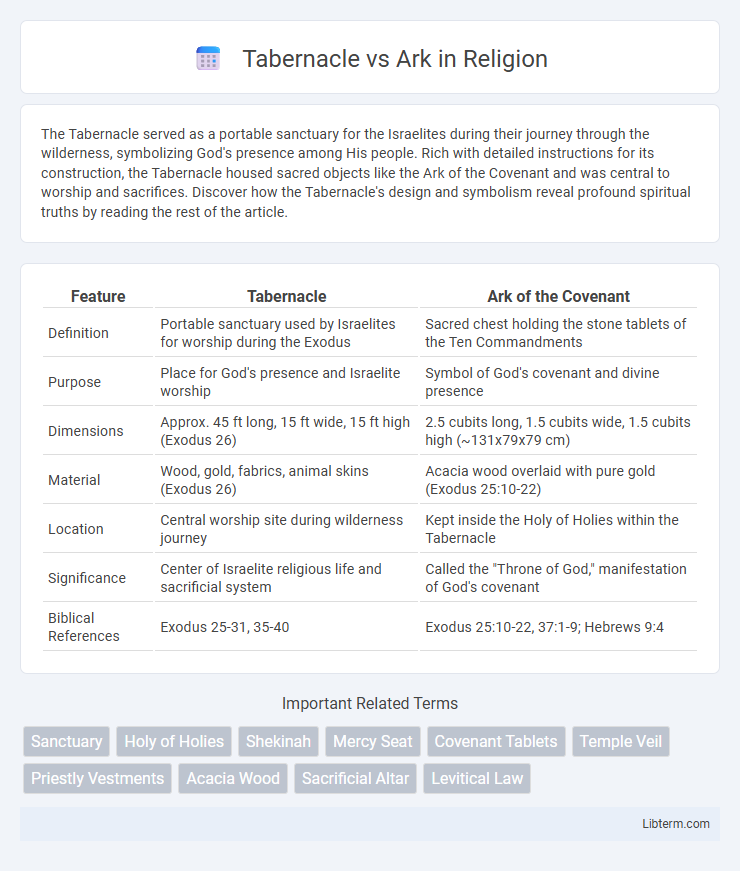The Tabernacle served as a portable sanctuary for the Israelites during their journey through the wilderness, symbolizing God's presence among His people. Rich with detailed instructions for its construction, the Tabernacle housed sacred objects like the Ark of the Covenant and was central to worship and sacrifices. Discover how the Tabernacle's design and symbolism reveal profound spiritual truths by reading the rest of the article.
Table of Comparison
| Feature | Tabernacle | Ark of the Covenant |
|---|---|---|
| Definition | Portable sanctuary used by Israelites for worship during the Exodus | Sacred chest holding the stone tablets of the Ten Commandments |
| Purpose | Place for God's presence and Israelite worship | Symbol of God's covenant and divine presence |
| Dimensions | Approx. 45 ft long, 15 ft wide, 15 ft high (Exodus 26) | 2.5 cubits long, 1.5 cubits wide, 1.5 cubits high (~131x79x79 cm) |
| Material | Wood, gold, fabrics, animal skins (Exodus 26) | Acacia wood overlaid with pure gold (Exodus 25:10-22) |
| Location | Central worship site during wilderness journey | Kept inside the Holy of Holies within the Tabernacle |
| Significance | Center of Israelite religious life and sacrificial system | Called the "Throne of God," manifestation of God's covenant |
| Biblical References | Exodus 25-31, 35-40 | Exodus 25:10-22, 37:1-9; Hebrews 9:4 |
Introduction to the Tabernacle and the Ark
The Tabernacle served as the portable sanctuary for the Israelites during their Exodus journey, designed to house the Ark of the Covenant. The Ark, a gold-covered wooden chest, symbolized God's divine presence and contained the stone tablets of the Ten Commandments. Together, the Tabernacle and Ark were central to Israelite worship and covenantal relationship with God.
Historical Context of the Tabernacle and Ark
The Tabernacle, a portable sanctuary constructed during the Exodus, served as the central place of worship for the Israelites, housing the Ark of the Covenant, which symbolized God's divine presence. Historically, the Ark was a sacred chest containing the stone tablets of the Ten Commandments, Aaron's rod, and manna, representing the covenant between God and Israel. The Tabernacle's design and function reflect ancient Israelite religious practices, emphasizing the Ark's role as the spiritual and covenantal core within the mobile worship space.
Purpose and Function of the Tabernacle
The Tabernacle served as the portable sanctuary for the Israelites during their Exodus, designed for worship and divine presence among the people. It housed the Ark of the Covenant, which contained the Ten Commandments and symbolized God's covenant with Israel. The primary function of the Tabernacle was to facilitate sacrificial rituals, prayer, and communion between God and His people.
Purpose and Symbolism of the Ark
The Ark of the Covenant served as the sacred container for the stone tablets of the Ten Commandments, symbolizing God's covenant and presence among the Israelites. It functioned as the focal point of worship within the Tabernacle, representing divine authority, guidance, and holiness. The Tabernacle itself was a portable sanctuary housing the Ark, designed to facilitate God's dwelling with His people during their wilderness journey.
Construction and Materials Used
The Tabernacle was constructed using acacia wood, fine linen, goat hair, ram skins dyed red, and durable hides, with dimensions and design specified in Exodus 26. The Ark of the Covenant, made primarily of acacia wood overlaid with pure gold inside and out, measured approximately 2.5 cubits long, 1.5 cubits wide, and 1.5 cubits high, featuring gold-covered cherubim on its lid. Both structures emphasized divine specifications for materials and craftsmanship to ensure holiness and durability within the Israelite sanctuary system.
Key Differences Between Tabernacle and Ark
The Tabernacle served as a portable sanctuary for the Israelites, housing the Ark of the Covenant and facilitating worship rituals during their desert journey. The Ark of the Covenant was a sacred chest containing the stone tablets of the Ten Commandments, symbolizing God's covenant and presence. While the Tabernacle functioned as an entire worship structure with various components, the Ark was a specific holy object central to Israelite religious practices.
Religious and Spiritual Significance
The Tabernacle served as the portable sanctuary where God's presence dwelled among the Israelites, symbolizing divine guidance and covenant with His people. The Ark of the Covenant, housed within the Tabernacle's Holy of Holies, represented God's throne on earth and contained sacred items like the stone tablets of the Ten Commandments, embodying God's law and authority. Both structures hold profound spiritual significance, emphasizing God's holiness, His relationship with humanity, and the centrality of worship in religious tradition.
Role in Israelite Worship
The Tabernacle served as the portable sanctuary where Israelite worship rituals, including sacrifices and feasts, were conducted, signifying God's dwelling among His people. The Ark of the Covenant, housed within the Tabernacle's Holy of Holies, symbolized God's presence and covenant with Israel, containing the stone tablets of the Ten Commandments. Together, the Tabernacle and Ark played central roles in facilitating divine communication and covenantal worship in ancient Israel.
Legacy and Influence in Modern Faith
The Tabernacle's legacy endures as a symbol of God's dwelling among His people, influencing modern faith practices through portable worship spaces and the emphasis on holiness and divine presence. The Ark of the Covenant represents God's covenant and divine authority, shaping contemporary religious rituals and inspiring symbols of faith, protection, and covenantal relationship in Judeo-Christian traditions. Both artifacts profoundly impact worship, theology, and the spiritual identity of believers today.
Conclusion: Understanding Their Importance
The Tabernacle served as the portable sanctuary where God's presence dwelled among the Israelites, while the Ark of the Covenant was the sacred chest within the Tabernacle representing God's covenant and divine authority. Both hold critical significance in biblical history, symbolizing God's interaction with His people and His guidance. Recognizing their distinct yet interconnected roles deepens the understanding of ancient worship practices and spiritual symbolism in Judeo-Christian tradition.
Tabernacle Infographic

 libterm.com
libterm.com